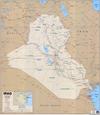As the fight against al Qaeda in Iraq moves to the northern provinces, where al Qaeda is attempting to assert command and control, the terror group’s fictitious leader, “Abu Omar al Baghdadi,” has called for a terror campaign against Iraqi forces aligning against him. Since the announcement of a new campaign against the Awakening movements, al Qaeda in Iraq has conducted nine high-profile attacks. These attacks outline where al Qaeda in Iraq is strongest.
Baghdadi, who is the creation of al Qaeda in Iraq leader Abu Ayyub al Masri and is actually played by an actor named Abu Abdullah al Naima, released an audiotape on December 3 outlining its “ghazw campaign” targeting the Awakening movements, the volunteer Concerned Local Citizens movements, and all who cooperate with them.
“Ghazw is a call for a campaign of short and sudden attacks to terrorize and demoralize both the enemy as well as non-combatants in order to weaken and eventually subjugate them,” ThreatsWatch noted. “The individual mission of each mujahid … is to conduct 3 IED attacks or 3 attacks with explosives, especially martyrdom attacks, or at least to kill 3 ‘apostates and traitors.'” the campaign is to end on or around January 29, 2008. “Ghazw was originally an Arabic term referring to the battles in which Muhammad personally participated” but “it has since evolved into a term for battle associated with the expansion of Muslim territory,” Wikipedia noted.
Since the announcement of the “ghazw campaign,” al Qaeda has conducted eight significant attacks in the North and Northeast, and one inside Baghdad. On December 3, a suicide bomber attacked near a police station in Jalula in Diyala province. Eight police, soldiers and civilians were killed and 30 wounded. On the same day, Sheikh Ata Allah Iskandar Habib, a member of Hawijah Awakening Council, and his driver were killed in a drive by shooting.
On December 5, 18 people were killed and 20 wounded in a car bombing targeting an Iraqi Army patrol in Baghdad’s Karrada neighborhood. In Baqubah, five civilians were killed and 12 wounded in a car bomb attack in Baqubah. Also, one civilian was killed and five wounded in a car bombing targeting a police patrol in Mosul. The next day, eight Iraqi soldiers were killed and five wounded in an attack on the headquarters of an Iraqi Army brigade in the Qara Taba district in Diyala.
Al Qaeda conducted three high-profile attacks in the North and East on December 7 and 8. A female suicide bomber killed 16 and wounded 27 when she detonated her vest “amidst a gathering of civilians in central Miqdadiyah district” in Diyala province. “A female suicide bomber attacked the popular committees [Concerned Local Citizens] headquarters in al-Mualimeen neighborhood,” Voices of Iraq reported. That same day, a suicide car bomber “detonated a car crammed with explosives this afternoon targeting a joint checkpoint of the Iraqi army and the Miqdadiyah popular committees.” Seven Iraqi soldiers and three police volunteers were killed in the attack; eight were wounded. Today, al Qaeda in Iraq killed six and wounded 16 in a suicide car bombing targeting a police station in the city of Baiji in Salahadin province.
Al Qaeda’s pattern of attacks over the past week helps to highlight where the terror group is strongest, as well as the regions it hopes to recapture. The strikes are centered where al Qaeda has the resources to conduct such attacks. Five of the attacks were in Diyala province, with two in Miqdadiyah where al Qaeda is attempting to regroup. Two of the strikes occurred in Salahadin province, one occurred in Baghdad, and one in Mosul.
Al Qaeda attempted a similar offensive during the month of Ramadan this year. Al Qaeda announced its Ramadan assassination campaign through the Islamic State of Iraq, its political front organization, in two Internet postings. Al Qaeda formed “special security committees” with the purpose to “assassinate the tribal figures, the traitors, who stained the reputations of the real tribes by submitting to the soldiers of the Crusade. We will publish lists of names of the tribal figures to scandalize them in front of our blessed tribes.”
The offensive was unsuccessful, despite the assassination of Sheikh Abdul Sattar Abu Risha, the leader of the Anbar Awakening. The Anbar Awakening, which has been instrumental in pacifying the once dangerous Anbar province, failed to fold despite the loss of their leader.









2 Comments
Verrry intresting – – thanks. What’s with the vaunted Kurd fighters (Pegmersha[sp?]) that held Saddam’s hordes at bay, now that AQ is regrouping in the north? Why can’t their intelligence folks smoke out AQ in their midst, or don’t they have agents that are “arab” enuf?
While we’re on the subject, is there a specialized Iraqi intelligence service connected to the IA? Can they effectively penetrate AQ and Iranian-Iraqi agents’ groups in both countries.?
One more, then I’ll give you a break and stop. Can’t cars “packed with explosives” be indicated by their unusually heavy weight to passenger load ratio, even as they drive along over mobilized scales, to be diverted for further examination?
I’ve been absent from Pakistan, Iran, Iraq, Afghanistan and other locations for far too long.
This post shall be updated throughout the day, perhaps throughout the weekend. FYI.
I may even touch on recent events in Russia proper and some involving our own intelligence community – but for now I’ll just say that criminal and civil law oug…